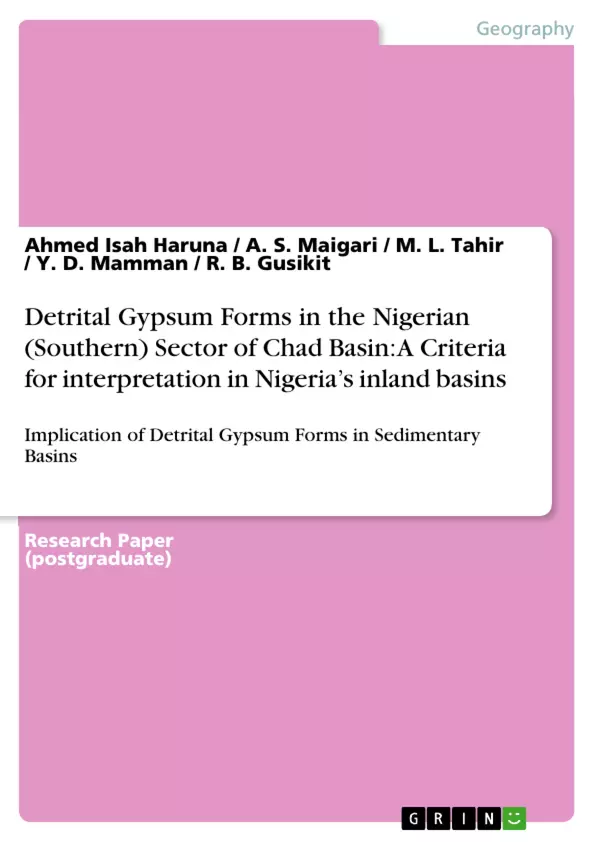The upper beds of Coniacian to early Maastrichtian Fika Shales are exposed within the Nigerian sector of Chad Basin to form the Shoreline environment hosting the mudflat that determines the rate of formation of detrital gypsum forms. The sequence of rocks are; Mudstone on top, Grey Shales at intermediate depth and Blue-Black Shales at deeper levels. Two main types of detrital gypsum forms are recognized based on depth of circulation of ground water and available structures within the Mudstone and Shales; (1) Disaggregated detrital gypsum (euhedral to subhedral hemipyramidal gypsum hosted by Mudstone and Grey Shales) and (2) Aggregated detrital gypsum (euhedral nucleation of vein-like gypsum hosted mainly by weathered Blue-Black Shales). The origin of detrital gypsum forms are inferred to be from the reworking and dissolution of thicker primary gypsum beds at depth due to circulation of meteoric water and groundwater and subsequent redeposition within available dessication and deformation structures in Shales and Mudstone when saturation is attained due to evaporitic pumping.
We recognized four facies association; the first form of Mudstone and gypsum-bearing Mudstone is a typical saline mudflat association. The second consist of disseminations of disaggregated subhedral detrital gypsum form around weathered primary gypsum beds within Mudstone; this is interpreted as sheetflow deposit due to reworking of mudflat facies during periods of heavy rainfall. The third consist of Grey Shales hosting well developed disaggregated euhedral-subhedral pyramidal detrital gypsum formed within the fissile structures; this is interpreted as precipitation of saturated sulfate fluid within closed pockets of fissile structures due to evaporitic pumping. The fourth consist mainly of weathered and deformed Blue-Black Shales hosting discontinuous concordant and discordant vein-like nucleation of the aggregated anhedral detrital gypsum; this is interpreted as nucleation of anhedral detrital gypsum within open fissile structures, karst structures and opened deformational structures due to rapid dissolution of primary gypsum beds and subsequent redepositon as a results of evaporitic pumping. These facies association allow the characterization of the Mudflat facies of the Shoreline environment of the Chad Basin that fall within the Nigeria’s sector of Chad Basin and similar environments in the Nigeria’s sedimentary basins.
Inhaltsverzeichnis (Table of Contents in English)
- ABSTRACT
- INTRODUCTION
- GEOLOGIC SETTING
- Chad Basin
Zielsetzung und Themenschwerpunkte (Objectives and Key Themes in English)
This paper aims to examine the formation of detrital gypsum forms in the Nigerian sector of the Chad Basin. It specifically focuses on how the reworking and redeposition of gypsum, influenced by evaporative pull, diagenetic reactions, and groundwater circulation, leads to the formation of different types of detrital gypsum structures within the shale formations.
- Formation of detrital gypsum forms in the Chad Basin
- Role of evaporative pull and groundwater circulation
- Influence of diagenetic reactions and structural features
- Identification and characterization of different detrital gypsum facies
- Comparison with similar environments in other Nigerian sedimentary basins
Zusammenfassung der Kapitel (Chapter Summaries in English)
The paper begins by introducing the context of detrital gypsum formation in evaporite basins, highlighting previous research on marine evaporites and limited work on continental lacustrine settings like the Chad Basin. It then provides a detailed description of the geologic setting of the Chad Basin, emphasizing its importance as the largest intracratonic drainage basin in Africa. The paper then outlines the stratigraphic sequence of the Chad Basin, specifically focusing on the Fika Shales, which host the gypsum mineralization.
Schlüsselwörter (Keywords in English)
Detrital gypsum, Chad Basin, evaporite basins, groundwater circulation, diagenetic reactions, facies association, shoreline environment, Nigerian sedimentary basins.
- Citation du texte
- Dr. Ahmed Isah Haruna (Auteur), A. S. Maigari (Auteur), M. L. Tahir (Auteur), Y. D. Mamman (Auteur), R. B. Gusikit (Auteur), 2007, Detrital Gypsum Forms in the Nigerian (Southern) Sector of Chad Basin: A Criteria for interpretation in Nigeria’s inland basins, Munich, GRIN Verlag, https://www.grin.com/document/202931



